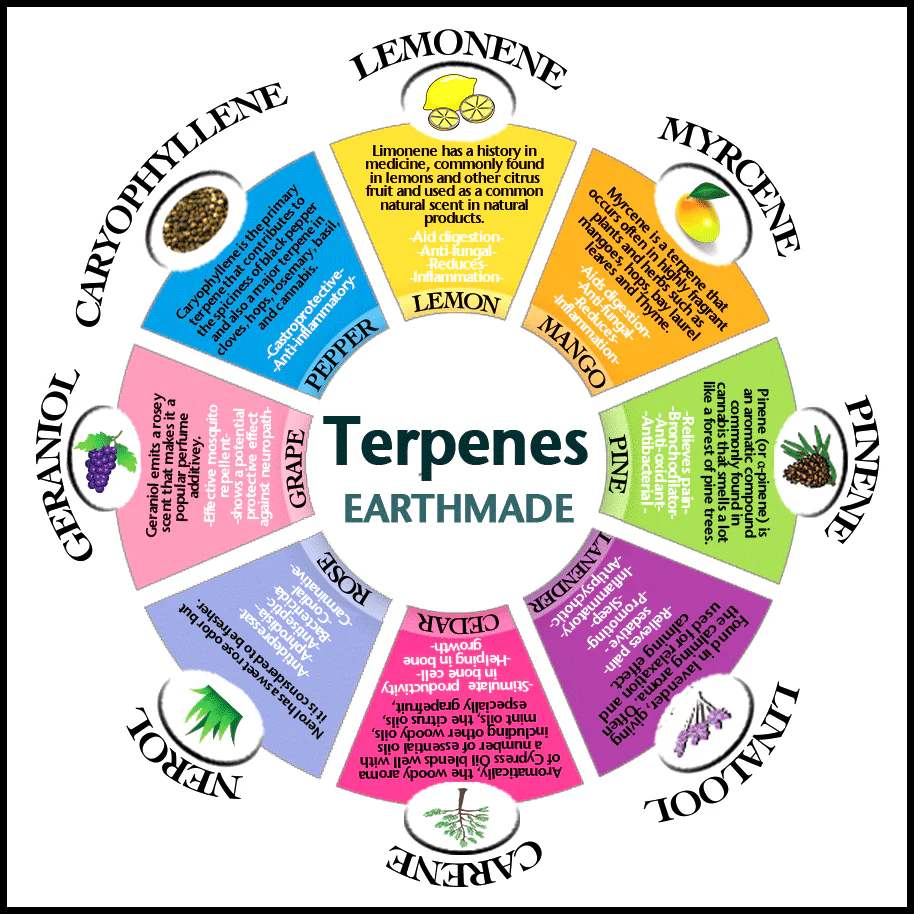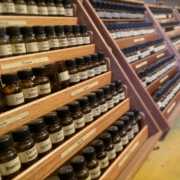The Role of Terpenes in Natural Fragrances

At the heart of natural scents lie compounds called terpenes. Terpenes are a manifold class of organic compounds produced by a variety of plants, particularly conifers, and are responsible for the distinctive aromas of many herbs and flowers. We will delve into the role of terpenes in natural fragrances, exploring their chemical nature, mechanisms of action, and the scientific evidence supporting their use.
Table of Contents
-
What are Terpenes?
-
Terpenes in Natural Fragrances
-
Mechanism of Action
-
Scientific Evidence Supporting Terpene Benefits
-
The Olfactory “Color” of Terpenes in Fragrances
What are Terpenes?
Terpenes are a large and diverse class of organic compounds, produced primarily by plants as secondary metabolites. They are responsible for many plants’ distinctive aroma and flavor and have been used for centuries in traditional medicine and aromatherapy. Terpenes are synthesized from the basic building block isoprene, a five-carbon molecule, and their structure can range from simple to highly complex.
Chemical Structure of Terpenes
The basic structure of terpenes consists of multiple isoprene units bonded together in various configurations. These structures can be linear, cyclic, or a combination of both. The diverse structures give rise to the wide variety of scents associated with terpenes. For example, the difference between the fresh, pine-like scent of α-pinene and limonene’s citrusy aroma lies in their molecular structures’ arrangement.
Terpenes in Natural Fragrances
Terpenes play a crucial role in the composition of natural fragrances. They not only contribute to the scent but also enhance the complexity and depth of fragrances. The interplay of different terpenes in a natural fragrance can result in a more nuanced and multi-layered olfactory experience.
Common Terpenes in Natural Fragrances
- Limonene: Found in citrus fruits, it has a fresh, zesty scent and is known for its uplifting effects.
- Linalool: Present in lavender and coriander, linalool has a floral, slightly spicy aroma and is known for its calming properties.
- α-Pinene: Common in pine trees, this terpene has a fresh, woody aroma and is believed to have alertness-enhancing properties.
- Eucalyptol: Found in eucalyptus, it has a fresh, camphoraceous scent and is known for its respiratory benefits.
- Myrcene: Found in hops and lemongrass, myrcene has an earthy, musky scent known for its sedative effects.
Sources of Natural Terpenes
Natural terpenes are extracted from various plant sources using methods such as steam distillation, cold pressing, and solvent extraction. Common sources include:
- Flowers: Lavender, rose, jasmine.
- Fruits: Citrus fruits like oranges, lemons, and limes.
- Herbs: Basil, thyme, rosemary.
- Trees: Pine, cedar, eucalyptus.
Mechanism of Action
Terpenes interact with the human body in several ways, primarily through the olfactory system. When inhaled, terpenes bind to receptors in the nose, sending signals interpreted as smell signals to the brain. This process can influence mood, behavior, and physiological responses.
Olfactory Mechanism
The olfactory system is responsible for detecting and processing smells. When a terpene molecule enters the nasal cavity, it binds to olfactory receptors located on the olfactory epithelium. These receptors send electrical signals to the olfactory bulb in the brain, which then processes and identifies the scent. Different terpenes bind to different receptors, leading to the perception of a wide range of scents.
Psychological and Physiological Effects
The impact of terpenes goes beyond scent perception. Studies have shown that terpenes can influence mood, stress levels, and even cognitive function. For instance, inhaling linalool, a terpene found in lavender, has been shown to reduce anxiety and promote relaxation. This effect is thought to be mediated through the modulation of neurotransmitters such as serotonin and dopamine.
Scientific Evidence Supporting Terpene Benefits
Aromatherapy and Mood Regulation
Aromatherapy, the practice of using essential oils for therapeutic purposes, relies heavily on the effects of terpenes. Research has shown that certain terpenes can significantly impact mood and emotional well-being. A study published in the journal Molecules (2017) demonstrated that inhaling linalool can reduce anxiety-like behavior in animal models, suggesting potential applications for managing anxiety and stress in humans.
Antimicrobial and Anti-inflammatory Properties
Terpenes possess various biological activities in addition to their psychological effects. For instance, eucalyptol, a major component of eucalyptus oil, has been shown to exhibit strong antimicrobial properties. A study in BMC Complementary and Alternative Medicine (2016) found that eucalyptol effectively inhibited the growth of several bacterial strains, including Staphylococcus aureus. Similarly, limonene has been shown to possess anti-inflammatory properties by modulating the release of pro-inflammatory cytokines.
The Olfactory “Color” of Terpenes in Fragrances
Fragrances can be described in terms of colors and temperature, which help perfumers classify them according to their emotional and sensory impact. Here’s how different terpenes contribute to these olfactory colors:
1. Green and Fresh Terpenes
Terpenes that evoke a green, crisp, and uplifting scent often have a fresh, botanical quality.
-
Limonene (Citrusy, Bright, Yellow-Green)
- Found in: Citrus peels (lemon, orange, grapefruit).
- Aroma: Zesty, sparkling, uplifting, juicy.
- Olfactory color: Yellow-green; evokes sunshine, freshness, and a dynamic, energetic feel.
-
α-Pinene and β-Pinene (Forest Green, Herbal)
- Found in: Pine needles, rosemary, eucalyptus.
- Aroma: Crisp, fresh, resinous, coniferous.
- Olfactory color: Deep green; associated with the outdoors, forests, and herbal vitality.
-
Eucalyptol (Cool, Blue-Green, Medicinal)
- Found in: Eucalyptus, bay leaves, camphor.
- Aroma: Clean, camphoraceous, slightly minty.
- Olfactory color: Blue-green; evokes coolness, medicinal purity, and clarity.
2. Warm and Golden Terpenes
Some terpenes add a warm, glowing, golden aspect to a fragrance, often used in comforting and cozy compositions.
-
Myrcene (Warm, Amber-Honey)
- Found in: Hops, mango, bay leaves.
- Aroma: Musky, earthy, balsamic, slightly fruity.
- Olfactory color: Golden brown; adds softness, warmth, and a sensual, rich quality.
-
Linalool (Lavender, Soft Purple, Powdery)
- Found in: Lavender, coriander.
- Aroma: Floral, soft, slightly spicy, soothing.
- Olfactory color: Soft lilac-purple; associated with relaxation, elegance, and a dreamy atmosphere.
-
Farnesene (Warm, Green-Gold, Apple-like)
- Found in: Apple peels, chamomile.
- Aroma: Fruity, floral, fresh apple skin.
- Olfactory color: Yellow-green; creates a natural, cheerful feeling.
3. Woody, Earthy, and Deep Terpenes
Some terpenes provide a dark, grounding, woody character to fragrances, reinforcing their depth.
-
Humulene (Dry Wood, Brown-Grey, Earthy)
- Found in: Hops, sage, ginseng.
- Aroma: Woody, slightly spicy, dry.
- Olfactory color: Brown-grey; evokes dryness, depth, and a natural rustic feel.
-
Cedrene (Deep Brown, Resinous, Sacred)
- Found in: Cedarwood, juniper.
- Aroma: Warm, resinous, dry wood.
- Olfactory color: Deep brown; reinforces a mystical, smoky, and ancient aroma.
-
Patchoulene (Dark, Earthy, Chocolate-like)
- Found in: Patchouli.
- Aroma: Deep, earthy, rich.
- Olfactory color: Dark brown; gives a grounding and sensual aspect.
4. Spicy, Red, and Exotic Terpenes
Spicy terpenes create a red or orange glow in perfumes, adding a feeling of warmth and sensuality.
-
β-Caryophyllene (Peppery, Red, Bold)
- Found in: Black pepper, clove.
- Aroma: Spicy, woody, dry, slightly smoky.
- Olfactory color: Fiery red-orange; adds boldness, mystery, and sensuality.
-
Germacrene D (Amber-Orange, Resinous, Oriental)
- Found in: Ylang-ylang, ginger, sandalwood.
- Aroma: Warm, balsamic, creamy.
- Olfactory color: Amber-orange; enhances exotic, luxurious blends.
Conclusion
Terpenes give natural fragrances their “color” and personality through their distinct olfactory profiles. From bright citrus yellows and forest greens to deep woody browns and spicy reds, terpenes shape the emotional and sensory experience of a fragrance. Understanding their role helps perfumers craft scents that evoke specific moods, atmospheres, and associations.
























Leave a Reply
Want to join the discussion?Feel free to contribute!